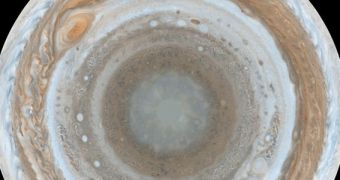A group of investigators from the Harvard University announce in a new study the discovery of what could be the key to the Great Red Spot's longevity. The GRS is a massive feature on Jupiter that has become the gas giant's tell-tale sign. It is, in fact, an extremely-large storm that may have been raging on the planet since 1665.
Though the Jovian atmosphere is vastly different than Earth's, the same basic principles apply. This means that the large storm should have subsided after a few decades at the most, not endure for centuries. According to the new study, the GRS is being kept alive by vertical wind flows.
Whenever the storm starts losing energy, hot and cold gases are moved vertically in and out of cloud formation, restoring some of its energy. Additionally, radial flows promote GRS longevity by sucking power from high-speed jet stream circling the storm into its center, Space reports.
The Great Red Spot is two to three times the size of Earth, measuring 20,000 kilometers (12,400 miles) in length and 12,000 kilometers (12,000 miles) in width. According to the sparse measurements we have on this storm, it would appear it produces winds in excess of 680 kilometers (425 miles) per hour.

 14 DAY TRIAL //
14 DAY TRIAL //